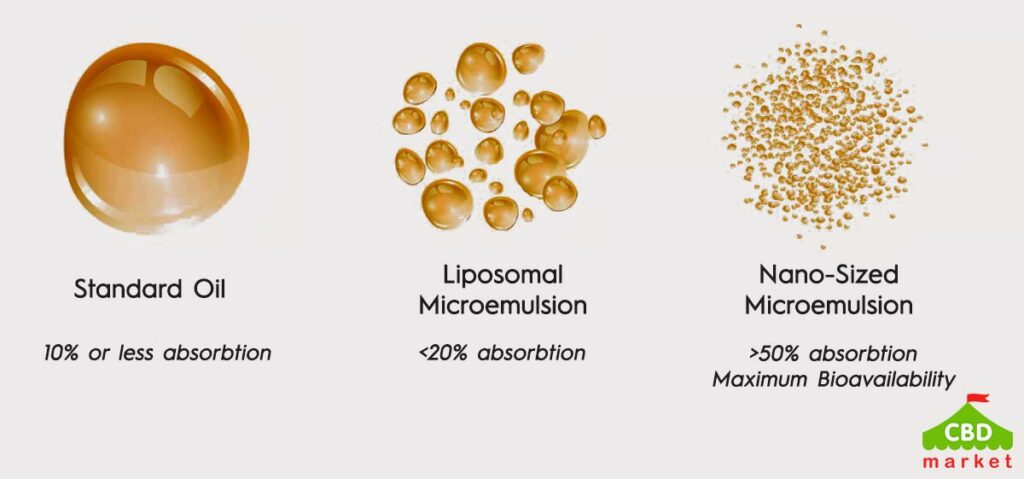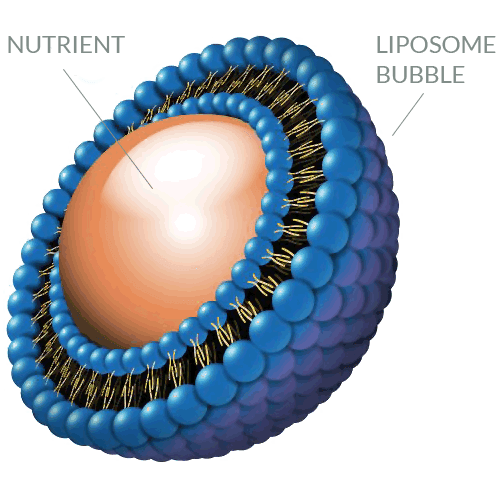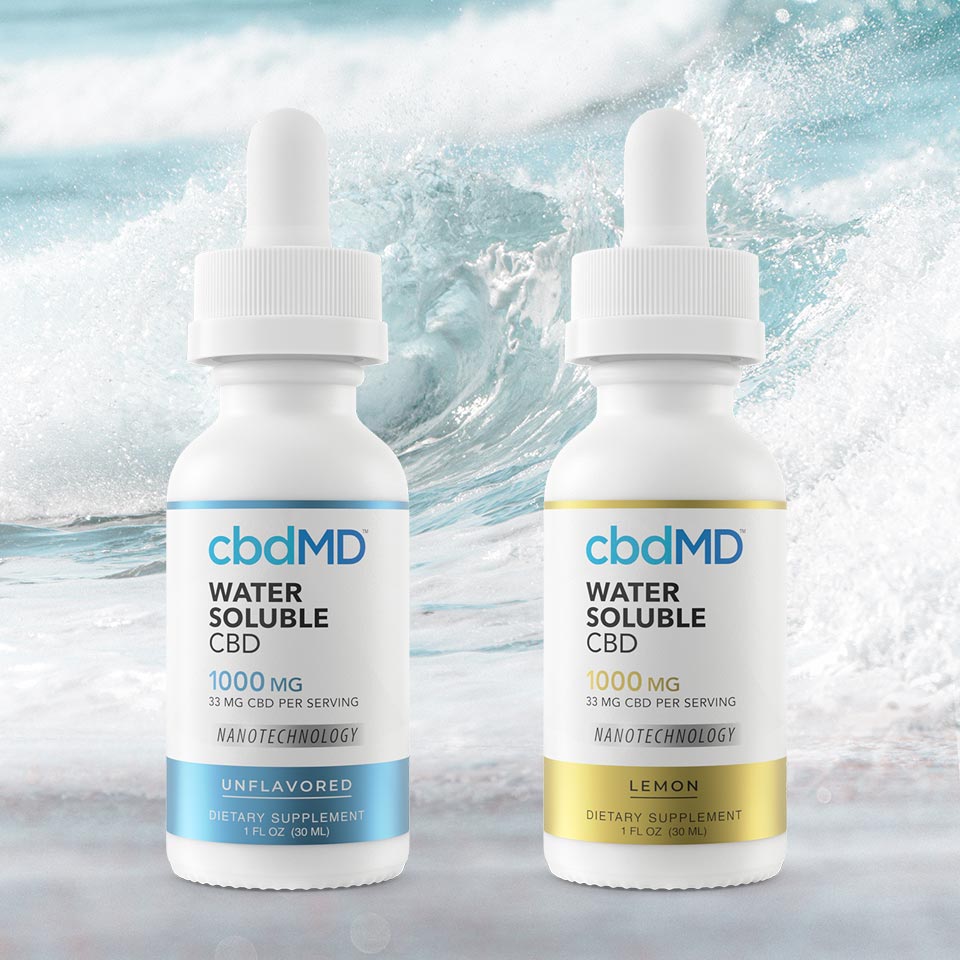What is Water-Soluble CBD and How Can You Take It?
Summarize

CBD has low water solubility and low bioavailability, so researchers continue to look for ways to improve both so that the full potential of CBD for therapeutics is reached one day. Since CBD is an oil, it does not naturally mix with water, but the body is as much as 70 percent water. Different approaches are being studied to improve CBD processing in the body, including making CBD water-soluble through nanoemulsion or liposomal technologies.

TL;DR (Too Long; Didn’t Read):
CBD oil does not mix with water due to its chemical properties. Since the body is made up of 45-75 percent water, CBD oil has a low bioavailability. Researchers have developed water-soluble CBD products that have a higher bioavailability, delivering the effects quicker and more efficiently. The two main technologies used today to produce water-soluble CBD is nanoemulsion and liposomal.
Table of Contents
CBD Oil vs Water-Soluble CBD
The expression “oil and water don’t mix” is based on science. The chemical properties of the two elements are different. Without getting too deep into chemistry, the water-soluble versus water non-soluble quality is based on polarity.
Water molecules are polar, meaning there is a negative charge due to the oxygen atom and a positive charge due to the hydrogen atoms. The polarity leads to the formation of strong hydrogen bonds with each other, so the water molecules are difficult to break up. Oil molecules are nonpolar and are called hydrophobic. Oil molecules are repelled by water molecules. Thus oil and water do not mix. The less-dense oil floats to the top of the water.
CBD is a fat-soluble substance, but the body is made up of 45-75 percent water. Oils are liquid fats. Since CBD is an oil, it is commonly formulated with other oils, like coconut oil or olive oil because the oils will not separate. The carrier oils used in CBD are really fats that at room temperature become liquid. CBD is highly lipophilic which means it has a high ability to dissolve in fats and oils.

The result is that CBD is not easily absorbed by the body and explains the general low bioavailability of CBD of 6-10 percent, depending on the type of CBD product used. The body cannot absorb most of the oil, so the CBD is eliminated naturally without having time to exert its full effects.
How is Water-Soluble CBD Produced?
To increase CBD bioavailability, the surface tension between the oil and water molecules needs release. There are two main methods used right now, though additional research is already leading to new processes.
1. Nanoemulsion Method
Nanoemulsion is a process for improving the low oral bioavailability of CBD oil due to the first-pass effect in which most of the product is eliminated from the body before reaching the bloodstream.
Nanoemulsified CBD products are made of oil and water, and a surfactant is added that releases the oil and water surface tension. The surface tension keeps the oil on top of the water.
Emulsion refers to two or more liquids that are not normally mixable i.e., oil is dispersed and water remains the same. Surfactants are used to encapsulate the CBD molecules to reduce the surface tension between the oil and water that is keeping the two elements separated. However, the smaller the droplets, the higher the bioavailability. Nanoemulsion refers to droplets of less than 200 nm that are surface protected by the surfactant. There are a variety of processes used to create the small droplets, such as microfluidization and self nanoemulsification, to name two. Research has shown that nanoemulsions increase solubility and bioavailability.
The CBD nanoparticles are put in a fatty emulsifier which dissolves the fat, making it easier to quickly reach the bloodstream.
2. Liposomal Method
Liposomal CBD is made by encapsulating CBD molecules in liposomes. Liposomes are tiny sphere-shaped thin-walled vesicles. Vesicles are fluid-filled sacs. The vesicles have one or more phospholipid bilayers with water inside and in-between the layers. They can trap water-insoluble ingredients in the membrane instead of repelling them.

This is the property that makes them suitable for making water-compatible CBD extracts. A typical liposome is made with cannabinoids, surfactants and an encapsulate.
New processes are being developed, like water-soluble electrospun fibers that disintegrate quickly and could release cannabinoids more rapidly than current encapsulation materials. The research is ongoing.
Benefits of Water-Soluble CBD
There are several CBD water-soluble benefits related to bioavailability and effects. They include:
- Higher rate of absorption of oral CBD
- Easier absorption of CBD in the GI tract due to smaller molecule sizes
- Faster absorption of CBD in the bloodstream due to the smaller molecule sizes
- Effects of CBD experienced at a much faster rate, i.e., 20 minutes versus 90 minutes or longer
- Uniform CBD mixture, which means a more consistent dosage each time
- Consistent particle size also contributes to more accurate dosing
- Mixes well in beverages compared to fat-soluble CBD
- Increased bioavailability means a smaller serving size is needed
How to Consume Water-Soluble CBD?
How to take water-soluble CBD? There are various products now available that make taking water-soluble as easy as taking traditional CBD products. For example, you can now buy a water-soluble CBD powdered drink mix that can be mixed in hot or cold drinks.
- Take water-soluble CBD softgels or capsules
- Add water-soluble CBD flavored powder or CBD oil to coffee, tea or other beverages
- Mix water-soluble CBD powder with water
- Take CBD sublingually by placing several drops of a water-soluble CBD tincture or CBD oil under the tongue, answering the question as to whether you can take water-soluble CBD under your tongue
- Take CBD oil orally by swallowing (compared to sublingually or under the tongue)
- Add the water-soluble CBD oil to food

Some water-soluble CBD products are made by isolating CBD in liquid. They may not have all the cannabinoids, flavonoids and terpenes you want in your CBD products. CBD broad-spectrum products are the primary spectrum options available today, but you will not get the full entourage effect because they are THC-free or only contain a trace of THC. The other potential drawback is that you might excrete CBD faster through urine.
Summary
The line of water-soluble CBD oil products continues to expand, and you can now easily buy water-soluble CBD online. Water-soluble CBD offers some benefits compared to CBD oil. You get more convenience with a higher bioavailability because you experience the effects sooner of a higher amount of CBD. If traditional CBD products are working for you, you can try a water-soluble CBD product and compare the results. It is the best way to determine if it will deliver the benefits you are looking for.
Sources
- https://www.ncbi.nlm.nih.gov/pmc/articles/PMC7558665/
- https://www.scientificamerican.com/article/mix-it-up-with-oil-and-water/
- https://www.ncbi.nlm.nih.gov/pmc/articles/PMC4207053/
- https://www.ncbi.nlm.nih.gov/pmc/articles/PMC8489317/
- https://covalentmetrology.com/wp-content/uploads/2021/05/D51IA053EN-A_ApplRep_PC_CBDemulsions.pdf
- https://www.ncbi.nlm.nih.gov/pmc/articles/PMC3599573/
- https://pubmed.ncbi.nlm.nih.gov/33400042/
Share this post


0